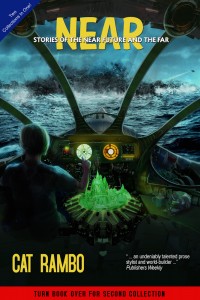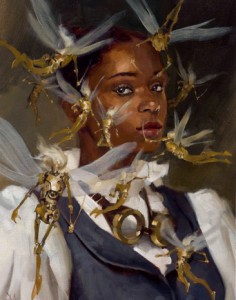 It’s always bothered me that fantasy and science fiction get lumped together into a single category. The two genres seem very different, at least on the surface. Fantasy usually features some kind of magic as a core speculative element. It often takes place in a secondary world at a pre-industrial state of technology. Science fiction, in contrast, usually takes us to the future in which some as-yet-nonexistent technology underlies the plot. Granted, there’s a huge overlap between fantasy and science fiction fandoms. Maybe that means we live for escapism, whether to a fantasy world or outer space.
It’s always bothered me that fantasy and science fiction get lumped together into a single category. The two genres seem very different, at least on the surface. Fantasy usually features some kind of magic as a core speculative element. It often takes place in a secondary world at a pre-industrial state of technology. Science fiction, in contrast, usually takes us to the future in which some as-yet-nonexistent technology underlies the plot. Granted, there’s a huge overlap between fantasy and science fiction fandoms. Maybe that means we live for escapism, whether to a fantasy world or outer space.
The Crossover Genre: Science Fantasy
It’s rare but wonderful when we get both sci-fi and fantasy elements in the same story (a genre sometimes called science fantasy). Dune is the first example that comes to mind. Disclaimer: Dune always comes to mind when I’m thinking of science fiction, because I love it so much. Most of the series is sci-fi: space travel, drones, laser rifles, and a sprawling galactic empire. But there are other elements that I’d call magic: the practices of the reverend mothers, for example, and the prescient powers achieved with a spice overdose. When the story goes out into the deep desert with the great sandworms, it feels like a fantasy to me.
I could also argue that the original Star Wars also blends the SF/F genres. The talking droids, epic space battles, and planet-blasting Death Star make it mostly a science fiction story, but there’s also magic that plays a pretty central role to the story. Like all great magic systems, this one is accessible to only a select few, requires considerable training, and has certain limitations. And it plays a key role in the central conflict. Obviously, I’m talking about the Force. It’s not just a magic system, but practically a religion among its practitioners.
Technology Versus Magic
The interplay between magic and technology in Star Wars is fascinating. When it comes to technology, the Empire has almost every advantage. Bigger, better ships. Armored combat walkers. And a planet-destroying space station, albeit briefly. The Rebellion’s scrappy fighters win unlikely victories against these overwhelming forces. They did so often with the aid of that mystic religion. The Force, in other words, can level the playing field.
Magic and technology as speculative elements actually have quite a bit in common. Given a new capability – either arcane or technological in nature – we tend to apply it to similar problems. Both serve as weapons (curses and lasers) or in defense from attacks (wards and deflector shields). Healing is another popular application, whether that’s with a medical tricorder or a fistful of athelas. The same goes for teleportation, construction, destruction, and many other forms of speculative wish-fulfillment.
Which Element Matters More?
Given their similarities, one has to wonder: in a world where both magic and advanced technologies exist, which side has the upper hand? It is tempting to say technology matters more, because a technical advantage is both practical and constant. If you have guns and they have bows, you’re likely to be victorious. If the technology gap is wide enough, Clarke’s third law might be applied: any sufficiently advanced technology is indistinguishable from magic.
Even so, I can’t help but notice that the scrappy underdogs facing a huge technology deficit often emerge victorious if they have magic on their side. In both Dune and Star Wars, the underdogs manage to topple powerful emperors. And in both cases, they do so with considerable help from arcane sources: the Jedi’s mastery of The Force, and the witch-like powers of Bene Gesserit. In a conflict between two mismatched sides, magic can be a powerful equalizer.
About the Author
Dan Koboldt (website) is a genetics researcher and fantasy/science fiction author from the Midwest. He is the author of the Gateway to Alissia series (Harper Voyager) about a Las Vegas magician who infiltrates a medieval world. He is currently editing Putting the Science in Fiction, (Writers Digest), a reference for writers slated for release in Fall 2018.
By day, Dan is a genetics researcher at a major children’s hospital. He and his colleagues use next-generation DNA sequencing technologies to uncover the genetic basis of pediatric diseases. He has co-authored more than 70 publications in Nature, Science, The New England Journal of Medicine, and other scientific journals.
Dan is also an avid hunter and outdoorsman. Every fall, he disappears into the woods to pursue whitetail deer with bow and arrow. He lives with his wife and three children in Ohio, where the deer take their revenge by eating all of the plants in his backyard. Follow him on Twitter as @DanKoboldt.
Enjoy this writing advice and want more content like it? Check out the classes Cat gives via the Rambo Academy for Wayward Writers, which offers both on-demand and live online writing classes for fantasy and science fiction writers from Cat and other authors, including Ann Leckie, Seanan McGuire, Fran Wilde and other talents! All classes include three free slots.
If you’re an author or other fantasy and science fiction creative, and want to do a guest blog post, please check out the guest blog post guidelines.






